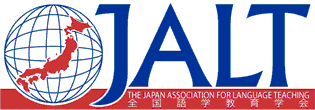16 January, 2021 - Justin Harris
An "input task output task framework" for TBLT in Japan
Justin Harris
In this month's presentation, Justin described Task Based Language Teaching (TBLT). The session was divided into five parts - a TBLT definition, why it is ideal for students in Japan, problems with TBLT, an Input Task Output Task Integrated Framework (ITOTIF) definition and practical applications of TBLT.
The TBLT can be quickly defined as one that focuses first on language's meaning rather than form. In other words, it has a strong communicative approach that allows students to try a task first before they focus on the language needed to carry out the activity. Learners focus on achieving a non-linguistic outcome that gives them a reason for communicating.
Harris gave a number of reasons as to why this sort of approach was ideal for Japanese students. Firstly, students in Japan from secondary school level have already studied a lot of language, but have had little chance to use this in communicative tasks. Also, with the test-based curriculum in Japan, the school system has set up students to fail if they haven't studied and memorized the language in a certain way. On the other hand, task-focused lessons are more forgiving or language mistakes so long as they complete the given task. This provides students with more freedom to think creatively using the language they know and therefore results in a more motivating challenge.
In the past however, TBLT has been criticized as over-reliant on students' current knowledge to produce language and it does not provide enough teaching input to support language acquisition. Justin suggests one way to remedy this is to make input tasks an integral step in eliciting student language output. He uses a framework based on the ideas of Jane Willis that can be divided into three stages. These include Pre-tasks, Task cycle and Language Focus. Pre-task introduces the topic, necessary vocabulary and structures. The Task cycle involves students trying the task. At the Language Focus stage, there is a reflection on the language used and practice of areas of weakness.
Justin takes this framework and adapts it his methodology called ITOTIF (Input Task Output Task Integrated Framework). In most textbooks, Justin finds that lessons flow in the following order:
- Presentation of target vocabulary
- Grammar practice
- A production task using what students have just been learned from 1 and 2.
Steps 1 and 2 are teacher input related activities, while 3 is an output task. As an alternative to this, Justin has incorporated input and output tasks throughout the syllabus. An example of how he did this was demonstrated in a reading lesson from one of his textbooks. Usually before students read something, there might be explicit teaching of new words and/or a warm-up discussion question related to the text. The alternative approach here is to skip these activities, and instead provide students with a task of creating their own original story as the pre-reading activity. Once they have completed this, students then read the story in the text. Because the students were now curious to see how well they predicted the article's contents, there was now real motivation for them to read for meaning. This could then be followed by a post-task comprehension check such as listing the events of the article in their correct order. Finally, as completion of the Input/Output cycle an output speaking task could be used where students talk about a topic related to aforementioned article.
In summary, Justin's method allows for teacher-centred instruction, but prioritizes student autonomy by providing chances for the students to work with the language and think for themselves first.
Link to meeting listing

